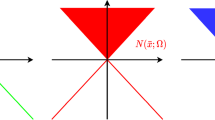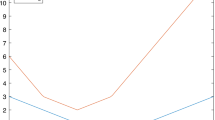Abstract
We are motivated by the problem of constructing aprimal-dual barrier function whose Hessian induces the (theoreticallyand practically) popular symmetric primal and dual scalings forlinear programming problems. Although this goal is impossible toattain, we show that the primal-dual entropy function may provide asatisfactory alternative. We study primal-dual interior-pointalgorithms whose search directions are obtained from a potentialfunction based on this primal-dual entropy barrier. We providepolynomial iteration bounds for these interior-point algorithms. Thenwe illustrate the connections between the barrier function and areparametrization of the central path equations. Finally, we considerthe possible effects of more general reparametrizations oninfeasible-interior-point algorithms.
Similar content being viewed by others
References
D.A. Bayer and J.C. Lagarias, "The nonlinear geometry of linear programming: I. Affine and projective scaling trajectories, II. Legendre transform coordinates and central trajectories," Transactions of the American Mathematical Society, vol. 314, pp. 499–581, 1989.
I.I. Dikin, "Iterative solution of problems of linear and quadratic programming," Soviet Mathematics Doklady, vol. 8, pp. 674–675, 1967.
S. Erlander, "Entropy in linear programs," Mathematical Programming, vol. 21, pp. 137–151, 1981.
R.M. Freund, "A potential reduction algorithm with user-specified phase I-phase II balance for solving linear program from an infeasible warm start," SIAM Journal on Optimization, vol. 5, pp. 247–268, 1995.
R.M. Freund and M.J. Todd, "Barrier functions and interior-point algorithms for linear programming with zero-, one-, or two-sided bounds on the variables," Mathematics of Operations Research, vol. 20, pp. 415–440, 1995.
C.C. Gonzaga, "Path following methods for linear programming," SIAM Review, vol. 34, pp. 167–227, 1992.
B. Jansen, C. Roos, and T. Terlaky, "A polynomial primal-dual Dikin-type algorithm for linear programming," Mathematics of Operations Research, vol. 21, pp. 341–353, 1996.
N. Karmarkar, "A new polynomial time algorithm for linear programming," Combinatorica, vol. 4, pp. 373–395, 1984.
M. Kojima, N. Megiddo, and S. Mizuno, "Theoretical convergence of large-step primal-dual interior point algorithms for linear programming," Mathematical Programming, vol. 59, pp. 1–21, 1993.
S. Mizuno, "Polynomiality of infeasible-interior-point algorithms for linear programming," Mathematical Programming, vol. 67, pp. 109–119, 1994.
S. Mizuno, M.J. Todd, and Y. Ye, "On adaptive-step primal-dual interior-point algorithms for linear programming," Mathematics of Operations Research, vol. 18, pp. 964–981, 1993.
R.D.C. Monteiro, I. Adler, and M.G.C. Resende, "A polynomial time primal-dual affine scaling algorithm for linear and convex quadratic programming and its power series extension," Mathematics of Operations Research, vol. 15, pp. 191–214, 1990.
J.L. Nazareth, "A reformulation of the central path equations and its algorithmic implications," Technical Report 94-1, Department of Pure and Applied Mathematics, Washington State University, Pullman, WA, 1994.
Y.E. Nesterov and A.S. Nemirovskii, Interior-Point Polynomial Algorithms in Convex Programming, SIAM Publications, SIAM, Philadelphia, 1994.
R. Polyak, "Modified barrier functions (theory and methods)," Mathematical Programming, vol. 54, pp. 177–222, 1992.
F.A. Potra, "A quadratically convergent predictor-corrector method for solving linear programs from infeasible starting points," Mathematical Programming, vol. 67, pp. 383–406, 1994.
M.J. Todd, "Scaling, shifting and weighting in interior-point methods," Computational Optimization and Applications, vol. 3, pp. 305–315, 1994.
M.J. Todd, "Potential reduction methods in mathematical programming," Mathematical Programming, Series B, vol. 76, pp. 3–45, 1997.
Y. Zhang, "On the convergence of a class of infeasible interior-point methods for the horizontal linear complementarity problem," SIAM Journal on Optimization, vol. 4, pp. 208–227, 1994.
Author information
Authors and Affiliations
Rights and permissions
About this article
Cite this article
Tuncel, L., Todd, M.J. On the Interplay among Entropy, Variable Metrics and Potential Functions in Interior-Point Algorithms. Computational Optimization and Applications 8, 5–19 (1997). https://doi.org/10.1023/A:1008637929927
Issue Date:
DOI: https://doi.org/10.1023/A:1008637929927




